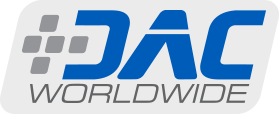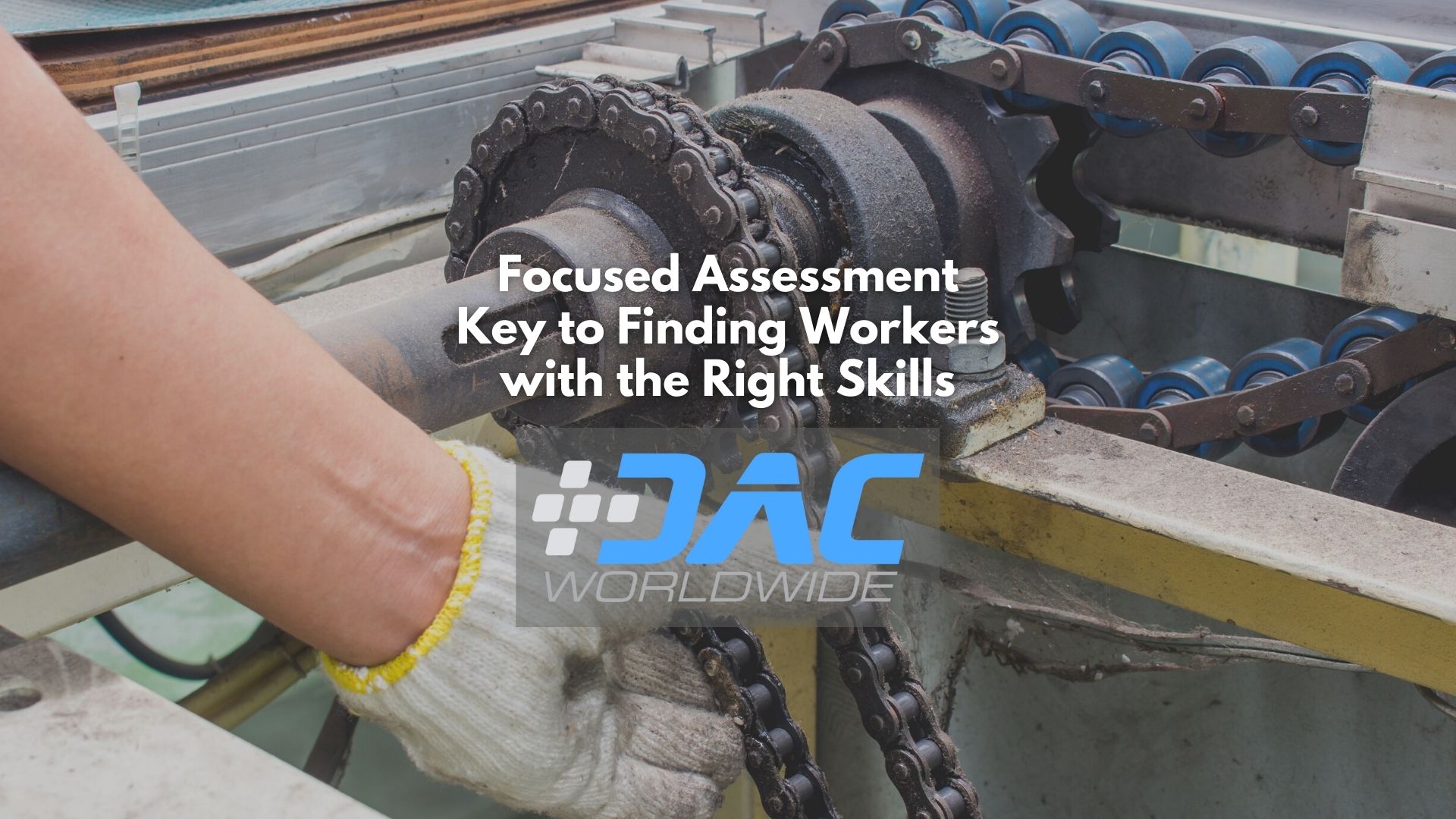
Click HERE to view Focused Assessment Key to Finding Workers with the Right Skills as a multimedia presentation.
“Now Hiring!”
These days, it seems like it doesn’t matter what type of business you’re in. If your business is open, then it probably has one of these signs in the window.
As industries across every sector continue to navigate the ups and downs of an uneven economic recovery in the wake of the ongoing COVID-19 pandemic, hiring managers are struggling to fill open positions.
Whether you’re an employer looking to fill critical roles or an instructor trying to prepare your students for available jobs, it’s important to understand that now, more than ever, workers need the right skills to be successful in the modern industrial workplace.
In this article, we’ll take a look at the issues employers face trying to find workers with the right skills. We’ll also explain the importance of focused assessment and how the training tools offered by DAC Worldwide can help employers and instructors assess and train workers for the jobs of today and tomorrow.
Why are there so many Open Manufacturing Jobs?
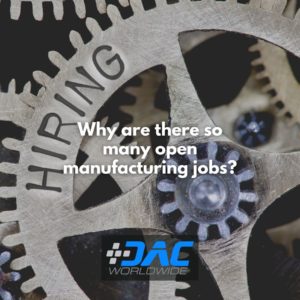 The COVID-19 pandemic took a heavy toll on manufacturers. Combining fluctuating demand with quarantining workers and vast supply chain disruptions, many manufacturers struggled to weather the many storms they faced.
The COVID-19 pandemic took a heavy toll on manufacturers. Combining fluctuating demand with quarantining workers and vast supply chain disruptions, many manufacturers struggled to weather the many storms they faced.
Now that we’re in an extended period of uncertain recovery, things should be slowly getting better. After all, unemployed people do need jobs, right? Instead, manufacturers seem to be falling farther behind.
According to an article by Alexandra Johnson:
“The US manufacturing industry is forecast to grow 7% in 2021, yet with this anticipated growth, the industry is struggling to hire enough workers to meet demand. Before COVID, the situation was bad, but post-pandemic it has become even worse. Despite lockdown lifting, the industry is reporting over 515,000 jobs need filling, just to meet demand.”
Why are so many manufacturers having such a hard time filling their many open positions? Experts believe that a big part of the problem is that too many workers simply don’t possess the skills employers need.
Today’s manufacturing workplace isn’t the dirty, boring, repetitive assembly line some people erroneously imagine. Modern facilities feature cutting-edge technologies that require specialized skills that not enough workers seem to have these days.
How can Manufacturers find Workers with the Right Skills?
With so many open positions to fill, it might seem like manufacturers should simply hire anyone they can get their hands on and then train them to do the jobs they need done. This approach, however, isn’t advisable for a variety of reasons.
Primarily, manufacturers who are already struggling with a whole host of issues don’t have the bandwidth to babysit new workers while they acquire the training they need. Many manufacturers also don’t have either the personnel or the tools to effectively train new workers.
In an article in the Harvard Business Review, LinkedIn CEO Ryan Roslansky advocates for a new skills-based approach to hiring. Roslansky argues that a skills-based approach “is the future of hiring and development…At a time when talent is the number-one commodity in business, companies can’t afford to remain stuck in old mindsets.”
Roslansky urges employers to “[f]ocus on the results you’d like to see, rather than the type of qualifications that you think could deliver them. Highlighting the desired skills — the candidate’s ability to perform certain tasks — gets to the same results without creating an unnecessary barrier to entry, like a requirement for a four-year degree.”
In an article by Adina Miron, the author agrees:
“Skills-based hiring enables employers to hire for the skills gaps that exist within their organization. Rather than focusing on experience, education, or certifications, companies should focus on identifying candidates with the needed skills to fill open positions.”
Roslansky echoes these thoughts:
“Shifting to a skills-focused approach is a viable solution to an evolving workforce dilemma…Stay focused on skills — and the assessments that can measure them…there are plenty of ways to gauge a candidate’s ability to perform without relying on their education or experience as proxies.”
A Skills-Based Hiring Approach Requires Proper Assessment & Training Tools
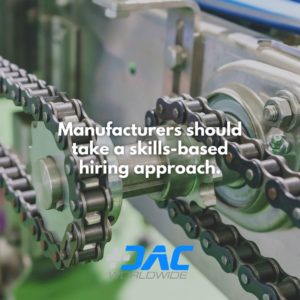 The nature of manufacturing makes generalized assessments and comprehensive training systems difficult to use in the context of hiring new workers. Why? The answer can be found in the concept of specialization of labor.
The nature of manufacturing makes generalized assessments and comprehensive training systems difficult to use in the context of hiring new workers. Why? The answer can be found in the concept of specialization of labor.
According to an article by Sampson Quain:
“Specialization of labor…refers to a process in business in which large tasks are divided into smaller tasks, and different employees or different groups of employees complete those tasks. Specialization is highly desirable in large-scale operations such as…manufacturing because it allows workers with specific skill sets to efficiently perform a specific task.”
For example, a manufacturer may need to hire someone with a specific skillset related to the operation, maintenance, troubleshooting, and repair of mechanical belt drives. A prospective candidate might claim to have general mechanical knowledge and skills, but how can the employer know whether the worker has the specific belt drive skills it needs?
To effectively use a skills-based hiring approach in manufacturing, employers need focused assessment and training tools that can be used to adequately determine a potential worker’s skills in a very specific area.
DAC Worldwide Offers Focused Assessment & Training Tools
Employers don’t need to recreate the wheel to move toward a skills-based approach to hiring. DAC Worldwide, an industry-leading manufacturer of technical assessment and training tools, offers a variety of solutions to the problems employers face.
In this section, we’ll take a closer look at several of DAC Worldwide’s focused assessment and training tools that employers can use to effectively and efficiently ensure that they’re hiring workers with the skills they need.
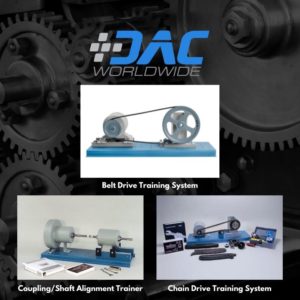 Belt Drive Training System (Model: 201-000)
Belt Drive Training System (Model: 201-000)
The Belt Drive Training System allows for convenient assessment and training in the identification, installation, tensioning, and alignment of common belt drives types found in industry. Featuring hardware for applications related to multiple matched belts, fractional horsepower belts, positive drive belts, and variable pitch sheaves, the system provides a variety of training and assessment applications in one benchtop piece of equipment.
Coupling/Shaft Alignment Trainer (Model: 208-000)
The Coupling/Shaft Alignment Trainer allows for realistic training and assessment in shaft alignment. Designed based on the dimensions of a common ANSI centrifugal pump, this trainer can assess and train workers on all common alignment techniques and tools. Training and assessment topics include using a dial indicator in coupling/shaft alignment, the reverse dial indicator method, fabrication of shaft keys, and installing a flexible disc coupling.
Chain Drive Training System (Model: 223-000)
The Chain Drive Training System allows for in-depth assessment and training in industrial chain drives, heavy/silent chains, and sprocket set usage. Using industry-standard components workers will encounter on the job, this training system provides a complete training and assessment experience covering topics such as taper lock bushings, chain drive maintenance, installation/alignment of chains, and tensioning of chains.
 Let DAC Worldwide Help You Fill Your Skills Gaps
Let DAC Worldwide Help You Fill Your Skills Gaps
The mechanical assessment and training tools highlighted above are just a few examples of the variety of technical training tools DAC Worldwide manufactures. In addition to training systems, DAC Worldwide also offers a wide range of industrial cutaways, detailed scale models, and sample boards featuring industrial components.
Contact a consultant with DAC Worldwide today to learn more about how their technical training tools can help you build the assessment and training program your company needs. Using DAC Worldwide training and assessment tools, you can transition to a skills-based hiring approach and fill the skills gaps in your organization!

